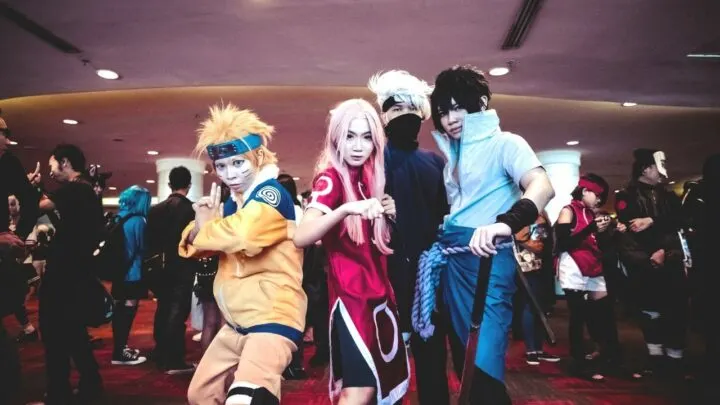Let’s talk about the rather niche topic of “Talk no Jutsu,” which comes out of the English speaking community of fans around the anime Naruto.
To anyone even passingly familiar with the phrase it’s just a simple, somewhat silly meme.
But I’m going to take it seriously here, discussing the word as it’s understood in the Anglosphere, as well as in Japan. As always, here at Linguaholic, we’re going to go way deeper than you expect on such a simple topic.
But before we jump in too deep, let’s do a quick overview…
What is the meaning of Talk no Jutsu?
Talk no Jutsu refers to the eponymous character of the anime Naruto and his ability to talk enemies down from their villainous beliefs. Jutsu means “skill or technique”; so, along with the connective particle no Talk no Jutsu means “Talking Technique.” It is debated if this is an “official” mystical jutsu, or simply a product of Naruto’s personality.
What is Naruto?
Naruto started out as a manga that ran from 1999 to 2014 and then as an anime from 2002 to 2017. It’s one of the best selling manga in history, and one of the most beloved anime to have ever been broadcast.
Naruto is the name of the manga/anime, but it’s all the name of the main character. In the story we follow Naruto from his pre-teen years until he has a kid of his own as he journeys to become a ninja of great skill and renown.
The name Naruto actually comes from the name of a food item in Japan. Naruto is a type of white fishcake that has a pink swirl in it. This is Naruto’s favorite topping on ramen.
A naruto can also refer to a whirlpool. Another word for whirlpool is uzumaki, which is Naruto’s family name. His ninja headband features a spiral, just like his namesake!
Now that we know a little about Naruto, let’s break apart the phrase “Talk no Jutsu.”
What is jutsu in Japanese?
The jutsu in Talk no Jutsu refers to the Japanese word that is written with the kanji (Chinese character) 術.
This character looks like it’s split into three parts, but it’s actually two! What we have is the semantic radical 行, which refers to a street intersection, along with a phonetic radical, 朮 (which gives us the jutsu pronunciation) jammed right in the middle.
While 行 originally referred to a street intersection, it came to hold the meaning of “going,” “moving,” and then “carrying out some task,” as well as “to be good at something.”
From this, it’s not a huge leap to see how 術 means “art, skill, technique.” Beyond that, it can also refer to “tricks” and “magic,” which fits in nicely with our mystical ninja topic today.
From this word we get some words that are familiar even in English!
忍術
ninjutsu
The combat and stealth skills of a ninja
柔術
jujutsu
The traditional Japanese martial at of Jiujitsu
剣術
kenjutsu
swordsmanship
Another “talk” jutsu…
There’s another word in Japanese that’s pronounced jutsu and it’s written with the kanji 述. This word means “dictation” or “verbal statement.”
While this rather unexpectedly fits the theme of “Talk no Jutsu” it is actually completely unrelated to the concept we’re talking about today. I just wanted to make sure that you’re aware of it so you don’t get tripped up if you see it in the wild!
What is “jutsu” in Naruto?
In Naruto, jutsu refers to the series of magical martial skills that a ninja can employ to in battle. Ninja practitioners will need to summon their “chakra” (a type of inner energy) and perform a “hand seal” in order to perform a specific jutsu.
With enough chakra and the right seal, a jutsu can do any number of things. There are hundreds, or possibly thousands of potential jutsu.
Some simple example include the ability to bind an enemy, perform simple striking attacks, force someone to relive terrible events from their memories, or multiply the number of weapons thrown at an enemy.
What does “no” mean in Talk no Jutsu?
The no in the phrase Talk no Jutsu has zero relation to the English word “no.” In Japanese, no is something called a “particle.” A particle is a little grammatical tool that has no meaning on its own.
Particles are used to mark words with their grammatical function. So, for example, there are particles that identify the subject/topic of a sentence, the direct object, or even the destination of an action.
No is a delightfully simple particle, written like a little swirl: の. No acts as a “connector” between two words, or can show possession. It can function like an apostrophe-s in English, or the word “of” or anything like that.
John の friend.
John’s friend.
Oxford の student
Student at Oxford (Oxford student)
Japanese の lesson
Japanese lesson
So, in the case of “Talk no Jutsu” it basically translates to “the skill of talking.”
What is Talk no Jutsu in Naruto?
As far as I can tell, the term “Talk no Jutsu” is never uttered in the show itself. It’s also known as Therapy no Jutsu, or is abbreviated as TnJ.
Neither of those seem to show up in the pages of the manga or the script of the anime either. Instead it’s an expression developed as a sort of meme within the fandom to describe Naruto’s impressive ability to talk to his enemies and, often, turn them into friends.
According to some sources, Talk no Jutsu has been confirmed by the creator of the manga as a “real” jutsu in the world of Naruto.
That is to say it’s a skill that can be learned, or taught, or inherited. However, since it doesn’t rely on chakras or seals there is some debate in the community how “real” it really is.
On the positive side of the debate, some argue that because it requires deep skill and understanding it is a real jutsu. For example, in order to expertly deploy the Talk no Jutsu, one must engage their empathy as well as their knowledge of their enemy.
Without a deep understanding of the opponent’s ideology, as well as their history, one cannot find the flaws in their thinking, nor how to relate to them on a personal basis.
The titular character Naruto is considered to be the best at Talk no Jutsu, with a nearly one hundred percent success rate.
Naruto will usually use this skill at the end of a battle, when he’s been badly physically beaten.
Of course, he can’t use this against just any enemy. For example, to mix fandoms here, let’s imagine him trying to fight 1992’s Doomsday from the Superman comics.
That character (originally) couldn’t speak or even think much. Without the ability to understand speech, or to reason, Naruto could never perform Talk no Jutsu on him. (Also, I mean, Doomsday killed Superman, so what chance would Naruto have anyway?).
That said, Talk no Jutsu is possibly the Naruto universe’s most powerful skill, and I think that’s pretty great.
A lot of fans think it’s cheesy, or weak writing, but I think it’s a great message to put across in a medium filled with heroes who solve 99% of all their problems with fists and energy blasts.
It’s not a bad thing to have a major hero who turns villains to friends with the power of compassion and understanding.
Is Talk no Jutsu just a Naruto thing?
No! It’s actually a real thing in Japan, though not exactly super common. It’s also written and said very slightly differently.
In Japan, they use katakana to write foreign words. So, “talk” become トーク, or toku. Plus, the “no” gets dropped. So, the phrase in Japanese, when it’s used, is トーク術, or toku-jutsu.
Let’s take a look at a few examples of how it’s used in everyday Japanese, pulling from articles and advertisements!
彼らはトーク術のプロ。
Karera wa toku-jutsu-no-puro.
They are professionals in the art of talking.
本書でお笑いトーク術を身に付ける
Honsho de o-warai-toku-jutsu o mi-ni-tsukeru
Learn the art of humorous rhetoric with this book.
持ち前のトーク術を駆使して、ふとした出来事を爆笑ネタに変身させているのです。
Mochimae-no-toku-jutsu o kushishite, futoshita dekigoto o bakusho neta ni henshin-saseteiru no des.
Making full use of their natural speaking ability, they transform ordinary tales into uproariously funny stories at the drop of a hat.
アナウンサーが”伝わる”トーク術を徹底解説!
Anaunsa ga “tsutawaru” toku-jutsu o tettei-kaisetsu.
An announcer thoroughly explains the “art of getting your message across”.
「売れない営業」を「デキる営業」に変えるセールストーク術
“Urenai eigyo” o “dekiru eigyo” ni kaeru serusu-toku-jutusu
Sales pitches to transform your poor sales into great sales
プレゼンも怖くない!説明上手になれるトーク術
Purezen mo kowakunai! Setsumei jozu ni nareru toku-jutsu.
Fearless presentations! The art of becoming good at explaining things.
営業で相手の心をつかむトーク術とは?
Eigyo de aite-no-kokoro o tsukamu toku-jutsu towa?
What is the art of capturing a customer’s heart with your words in business?
ですから、営業担当者は相手の心に訴えかけ、信頼しても良いと感じさせるトーク術を身に付けなければなりません。
Desukara, eigyo-tantosha wa aite-no-kokoro ni uttaekake, shinrai-shitemoyoi to kanjisaseru toku-jutsu o mi-ni-tsukenakerebanarimasen.
Therefore, sales representatives must learn to appeal to a person’s heart and communicate in such a way that they feel like they can trust them.
「インプロ(即興力)」というアドリブのトーク術をもとに書かれているんですよね?
“Inpuro (sokkyoroku)” toiu adoribu-no-toku-jutsu o-moto-ni kakareteirun-desu-yo-ne?
The writings are based on the art of ad-libbing, called “improvisation”, right?

“I’ve lived in Japan on-and-off for the last five years, travelling to (almost) every corner of the Land of the Rising sun. I’ve deepened my love of the language with big hauls from Sapporo book stores, by chatting in Shinjuku coffee shops, drinking in Osaka “snack bars,” exploring distant Okinawan islands, and hitching rides with monks in Aomori. Japanese is a wide and deep language, and I’m always eager to dive in deeper.”

